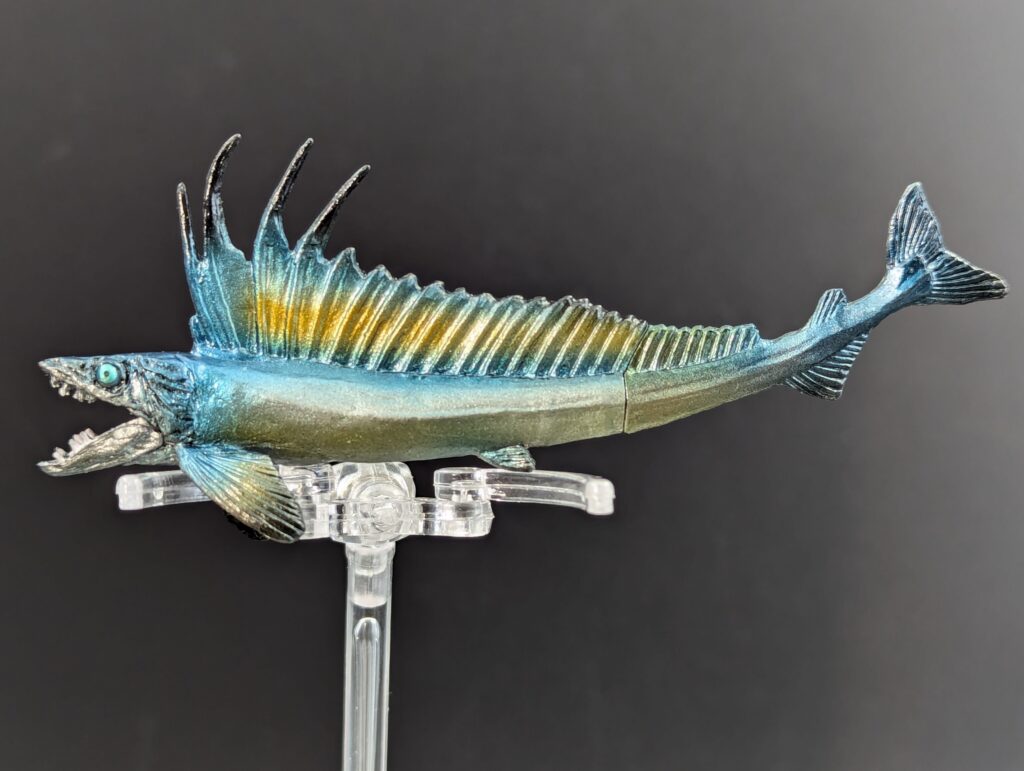
We’re back with another small figure from Bandai in their mini capsule series. I failed to recognize before that all of these models are part of what is now called the “Diversity of Life on Earth” series, which covers not only these capsule animals but a number of other figure types. In this case, this model is one of four species in the Deep Sea Fishes series (the only one I have–the others are oarfish, goblin shark and some kind of anglerfish). The one I needed to get was their take on the longnose lancetfish Alepisaurus ferox, a distinct, toothy predator of (mostly) deep waters.
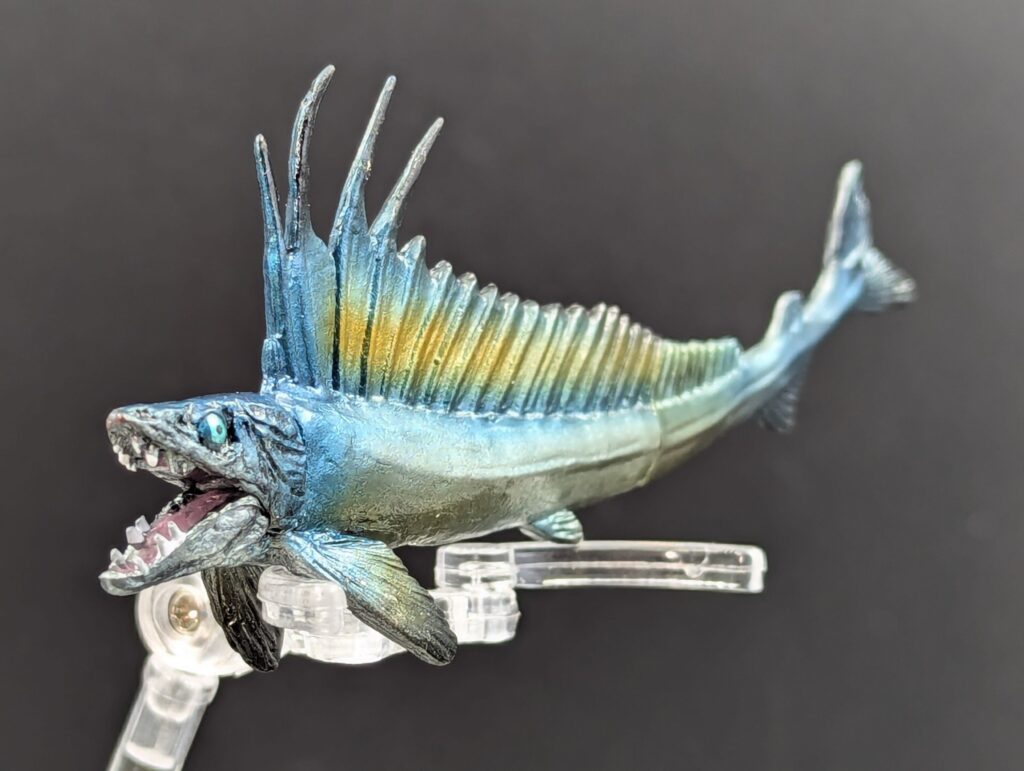
The longnose lancetfish is one of two living species in the family Alepisauridae, one of the families in Aulopifromes, the lizardfishes. Both Alepisaurus species are wide-ranging in the oceans, but the longnose is the more cosmopolitan, found throughout the Pacifc, Indian and Atlantic oceans, as far south as the southern tip of Chile and as far north as the coasts of Canada, Europe and Siberia. They do not venture into the polar Artic or Southern oceans. The other species (the shortnose lancetfish A. brevirostris, notable for it’s more stunted snout) is nearly as broad, except it is not found in the eastern Pacific, nor most of the Indian ocean. While primarily though of as ‘deep sea’ fish, preferring the mesopelagic and benthopelagic zones, they are also encountered in coastal surf zones and shallow areas. Overall these fish are solitary hunters, but occasionally can be found in larger associations for unknown reasons. While spawning behaviour is unknown, it is established that lancetfish are simultaneous hermaphrodites (bearing male and female reproductive organs at the same time).
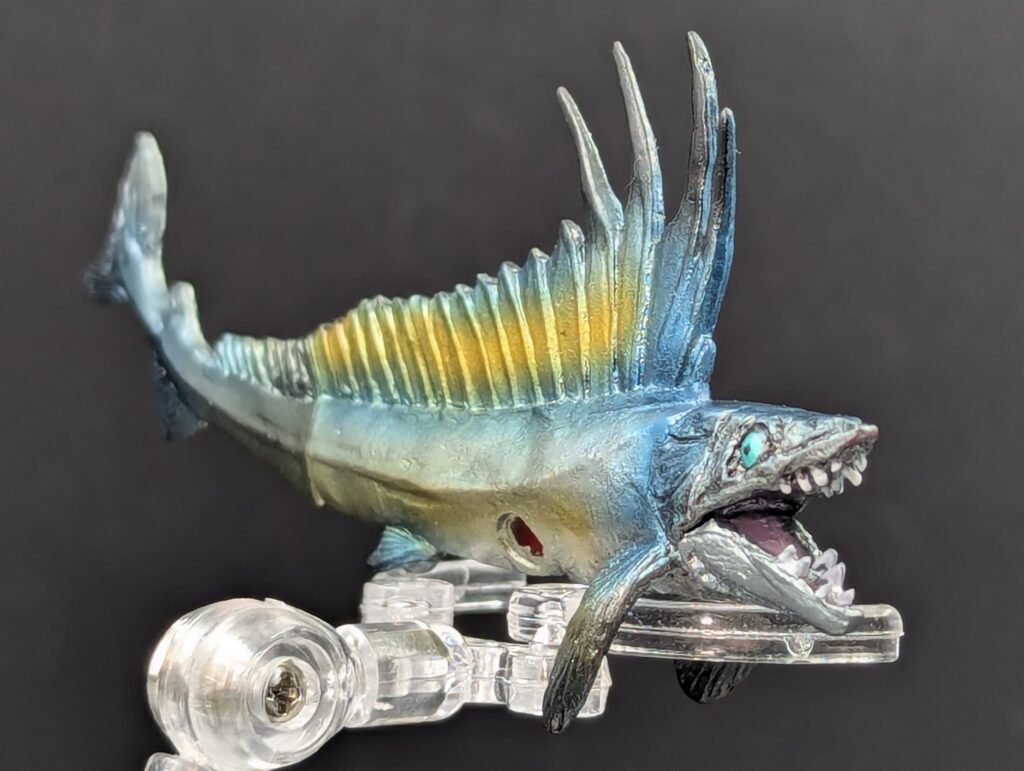
They are long-bodied but slender animals, up to 2.15 metres (over 7 feet) long with large eyes, a wide-gaping mouth bearing a few very long fangs in the lower jaw with several smaller pointed teeth, a distensible stomach, and a very noticeable high, broad dorsal fin. It is reminiscent of the sail of a sailfish, but is composed of soft rays, instead of the more solid rays familiar in fish like bass and perch (and sailfish!). These features indicate a highly predatory fish, but their muscles are relatively weak; it is suggested that these fish are ambush and not pursuit, predators, waiting in the water column for prey, then shooting forward in a short burst to grab prey–which can include pretty much whatever available organism is found in their current area, including smaller lancetfish (giving rise the alternate name of ‘cannibal fish’). It is though that the high dorsal fin helps to maintain the straight line of attack as the lancetfish shoots forward. Their broad range means that while not commercially fished (the flesh is watery and gelatinous…ew), their gut contents are studied to gauge what is eaten where–and apparently plastics are not uncommon in their guts alongside their actual prey. They are listed by the IUCN as Least Concern, and seem to be increasing in some commercial areas that practice long-line fishing.
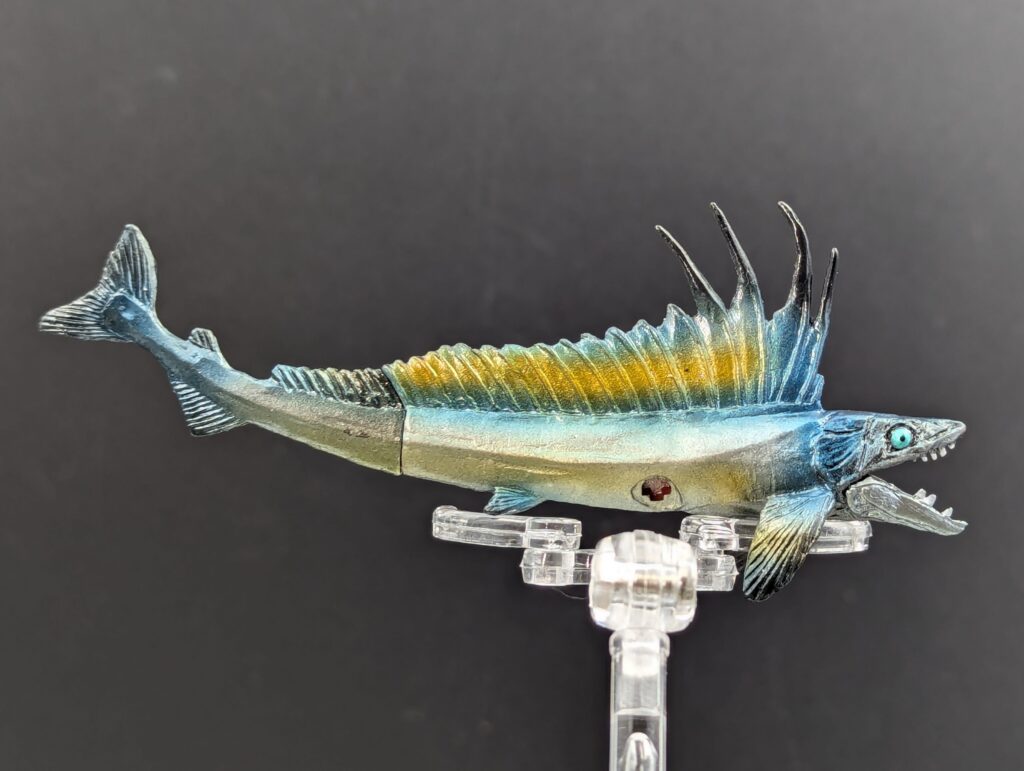
The figure itself is strikingly odd and kind of creepy-looking. It is posed in a mostly long and straight form, with a slight curve upward, especially at the tail. The overall mid-line length is 10.3cm (just over 4″) giving a max scale of 1:21. It is appropriately laterally compressed, widest at the opercula, with a pointed snout with a wide-open mouth, and dorso-ventrally tapering body. This is in keeping with the real fish, although it could possibly stand to be even more compressed vertically, they are very narrow. The figure is also broken into two pieces, as is common with DoLoE figures; unfortunately, the split is about midway between the pelvic and anal fins, so it stands out quite a bit–but the seem follows the line of the dorsal spines, so is less noticeable there. There is also a thin but distinct sculpted lateral line along the lateral half of the body; at the seam it doesn’t quite line up which is unfortunate. The model, as with other DoLoE figures, is mounted on a base, in this case stacked rocks, which doesn’t work quite right for a mostly pelagic fish, but they do occur in surf zones. It is attached through a shaped peg, removable like other figures like this (but not interchangeable).
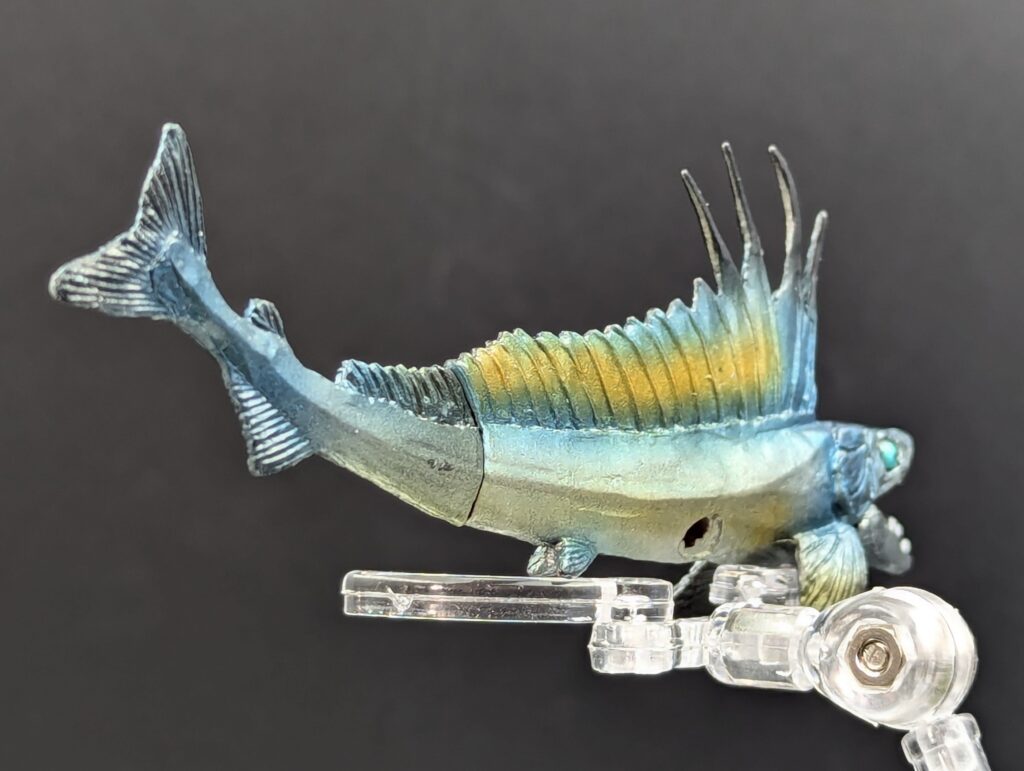
The most obvious body feature, the dorsal fin, is of course depicted very strongly. Although an intact specimen would see the dorsal fin be somewhat convexly rounded from front to back, it appears that the rays on these fish (soft, as mentioned) must frequently suffer breakage or other damage because there is a lot of variation when looking at examples. In the Bandai figure, the dorsal fin begins high at the front margin, tapering down along the length of the body; there is a short gap before a small adipose fin sticks up. There is a slight upward bump in the dorsal fin, just in front of the seam between pieces. The dorsal fin contains about 28 clearly marked rays (which is too low for those counting) which generally reach the high edge of the dorsal membrane, they are quite thick, maybe just a bit too thick given the scale. The exception is the front five rays–the first is very short, followed by a long, vertical ray that extends straight up; rays 3 through 5 are then ‘strongly exerted, meaning they extend quite high above the fin membrane, and are slightly to very recurved. I think this represents the ‘fraying’ that seems to happen in the dorsal fin, which can sometimes see a number of other randam dorsal rays jutting outward. There are also rays in the adipose fin, but this is a common mistake in fish figures…there shouldn’t be rays in adipose fins, that’s the whole point.
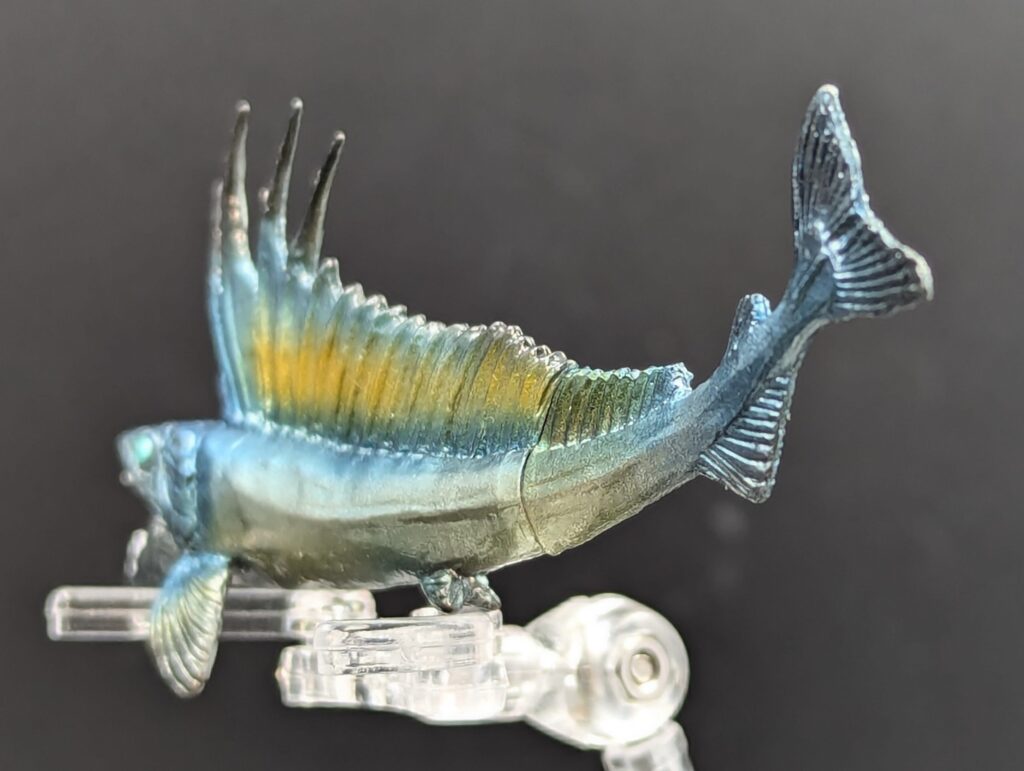
The rest of the finnage is also well-marked and sculpted. The tail fin is roughly symmetrical and forked, but not as deeply as it could be. The pectoral fins are broad and positioned straight down; these could be a little more pointed but I think they also vary in how much fraying they experience. The pelvic fins are small and triangular, and the anal fin is deeper, steeper on the front margin with a longer posterior edge along the body. Fin rays are also carefully sculpted into these fins, but more finely than on the dorsal fin (so they could have done it…)
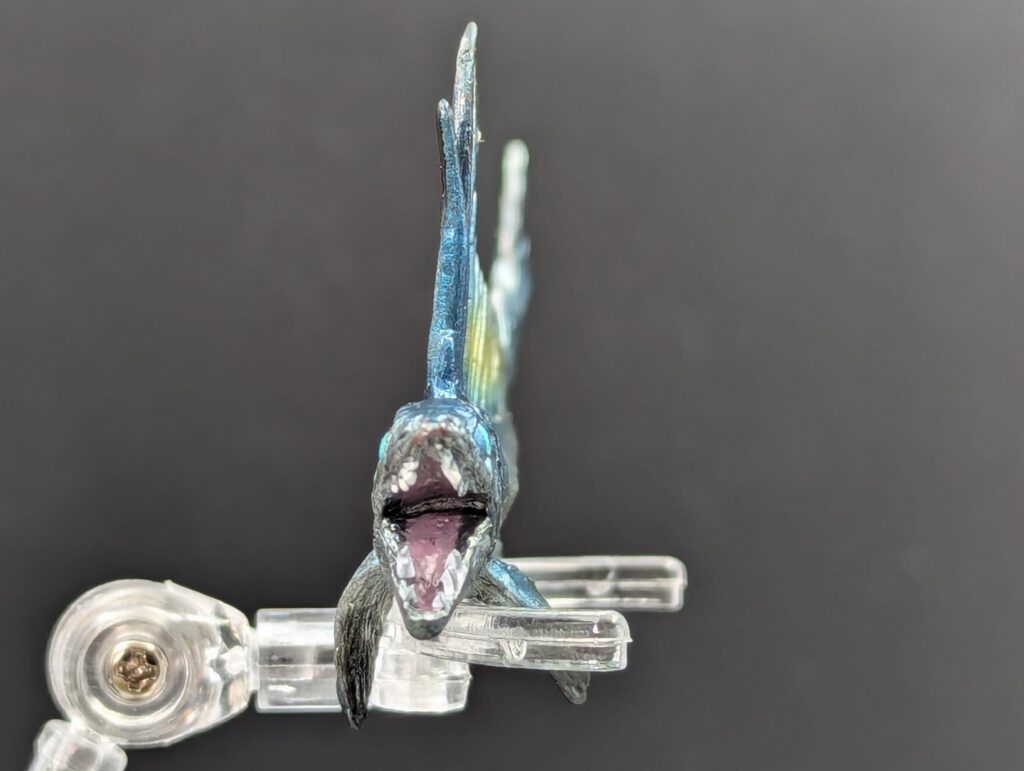

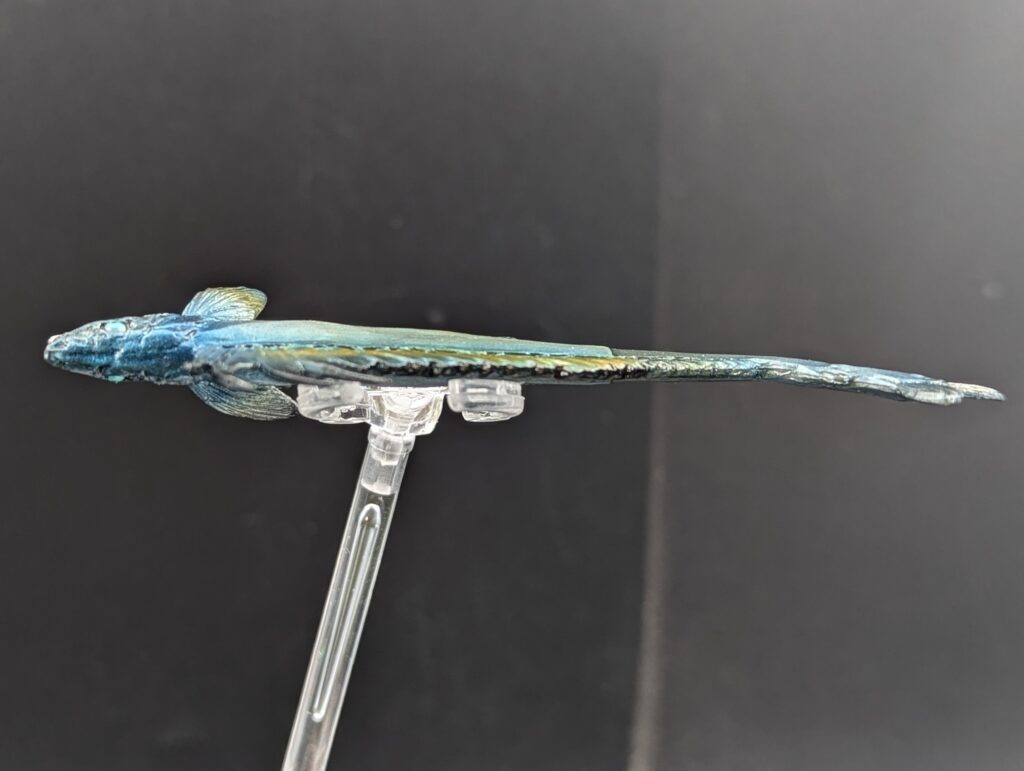
The other distinctive feature of the longnose lancetfish is of course the nose, and the associated scary face. Bandai definitely made this a big focus. The head is deep and pointed, with the jaw quite thin and gaping. The lower jaw contains three pairs of long fang-like teeth, and the upper jaw has several pairs of pointed but shorter teeth; there could have been some longer fangs here too. A tongue is sculpted into the mouth, and while there is some sculpting in the roof of the mouth, I’m not sure if it is meant to represent palatine teeth. The top of the head and opercula are inscribed with a number of marking indicating the skull attachment; they seem pretty symmetrical as is appropriate. The eyes are sculpted as large, bulging orbs, overall a light green with a dark, black pupil, which is about right for them.

The colouring of the figure is a little overly dramatic(!) Normally, this fish is silvery, maybe with an iridescent sheen, dark at the base of the dorsal fin. The fins are normally black or brown. On the figure, they did manage to capture the blackish colour on the ventral and and adipose fins, which seems about right. The dorsal fin so kind of a dark yellow in the centre, edged around all sides by a turquoise colour, and black on the extended fin rays. The main body itself is silver, but the latter part with the tail is the same turquoise as the dorsal fin. The head is also washed in black and the same turquoise. In fact, much of the figure is washed in turquoise–I think this is meant to be the aforementioned iridescence. It’s a little heavy-handed though, but does fit with the overall style of the DoLoE fish figures seen before, just a bit darker, giving a unique, somewhat stylized appearance. One thing of note on my figure–there is more of a dark wash on the tail piece, which highlights the difference between the two halves. It’s less noticeable when the figure is viewed obliquely, so that’s probably how I’ll display it.
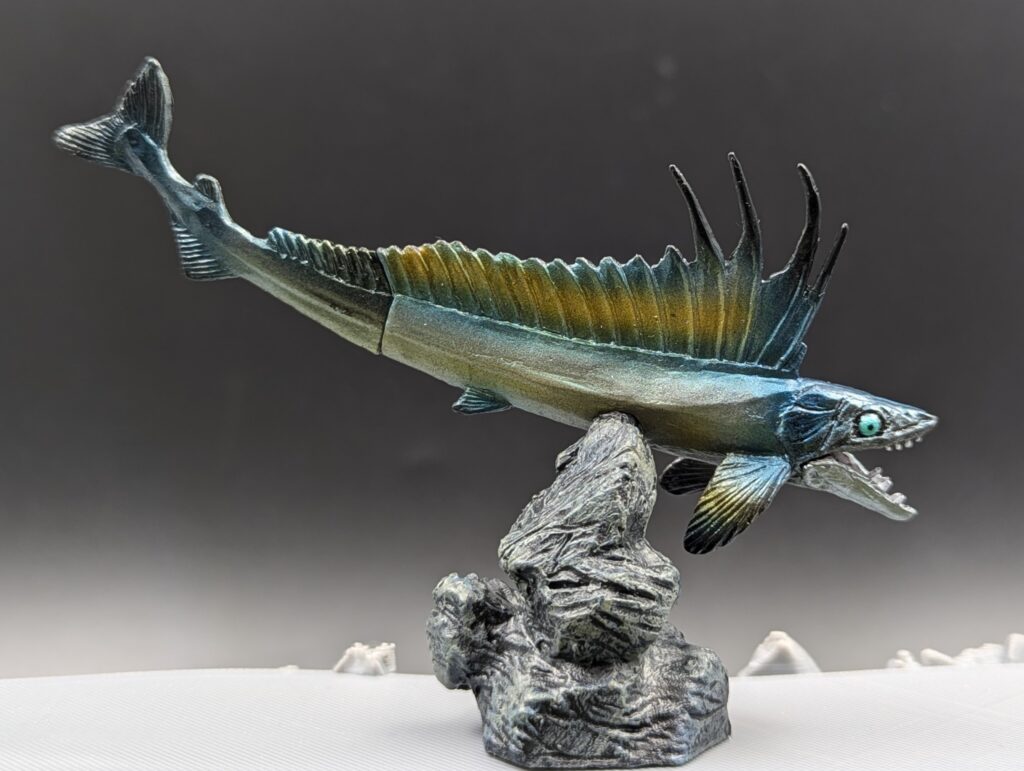
I would have to say that this figure is a really interesting one, a model of a unique deep sea fish that doesn’t get made often. There is another, from Kaiyodo, that is smaller and rarer–and probably a little better. I definitely suggest any figure collectors would benefit from adding this figure to their collection (maybe the other ones too, but I already have many representatives of those). I do understand that the seam is going to be irritating for some collectors, but angle it right and it might not be so noticeable. I do recommend trying to pick it up if it interests you! It’s not like there are a lot of aulopiform fish if you’re a (the Colorata tripod fish is the only other one I’m definitely aware of) so it would be a very distinct figure. But they are limited to Japan and nearby areas, so it will take a bit of searching.

Disclaimer: links to Ebay and Amazon on the AnimalToyBlog are affiliate links, so we make a small commission if you use them. Thanks for supporting us!




I initially considered replacing the Kaiyodo figure with this one, but glad I did not. Still, it looks better than the promotional materials indicated.
Yeah, I don’t usually delve too deep into comparisons, but the Kaiyodo is definitely more consistent (since it’s a single piece). But the Bandai is a little bigger, so it’s a little more impressive.
Being such a weird species, I don’t mind having two.